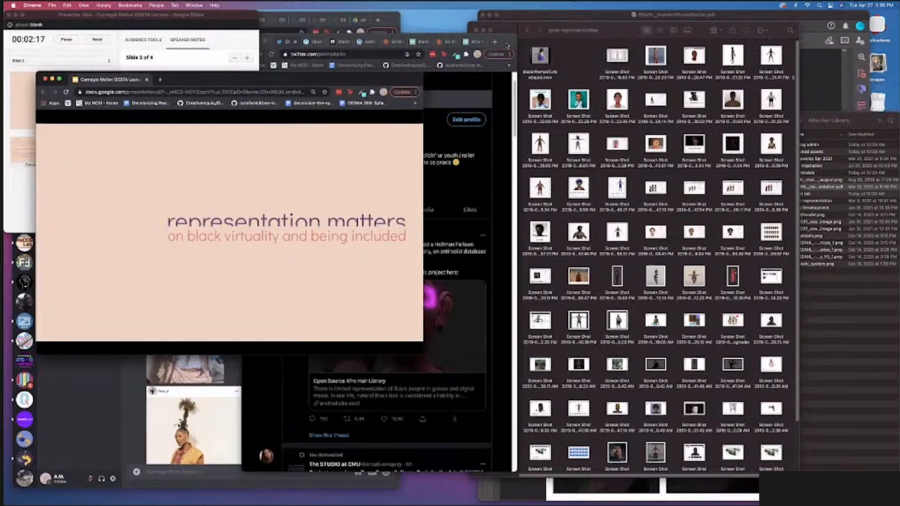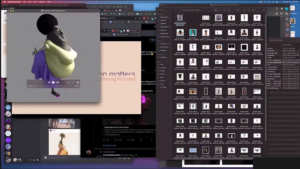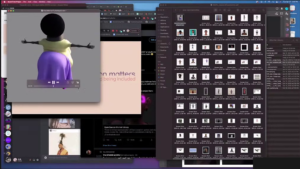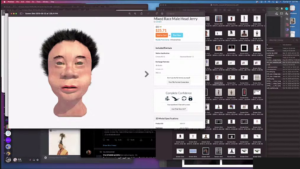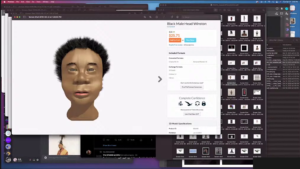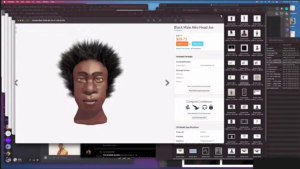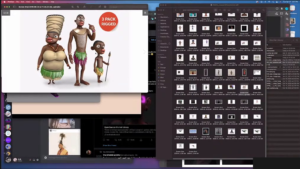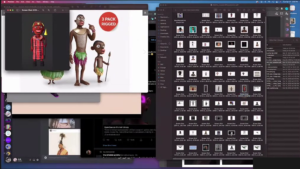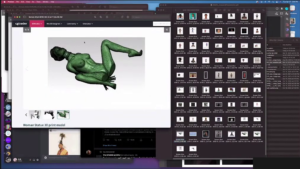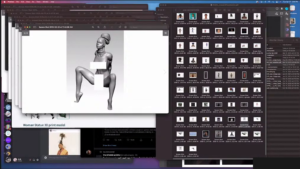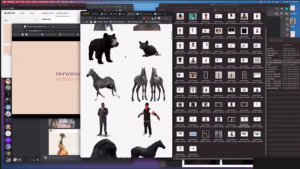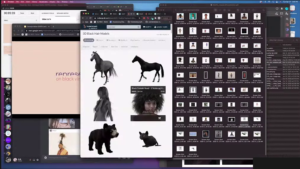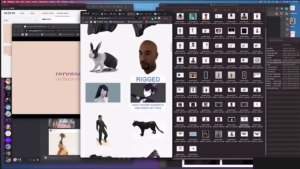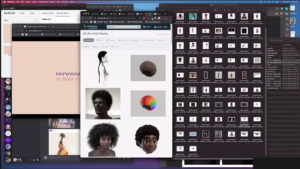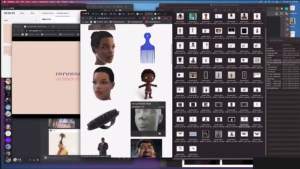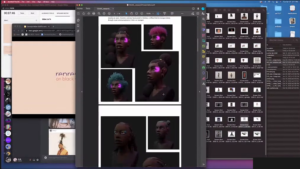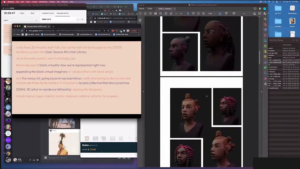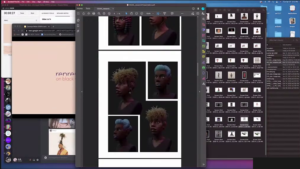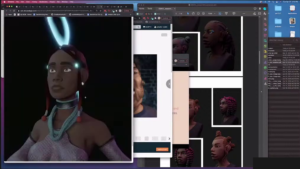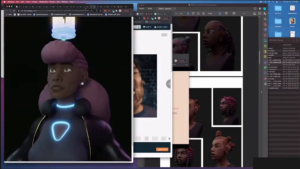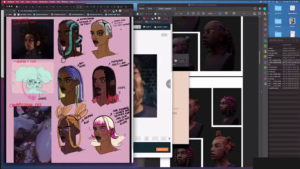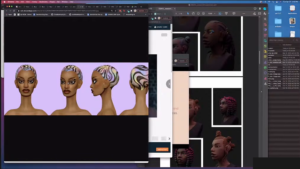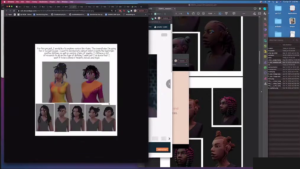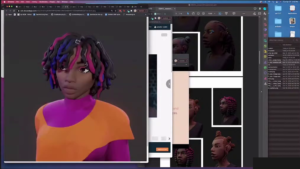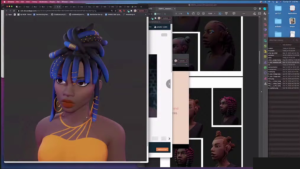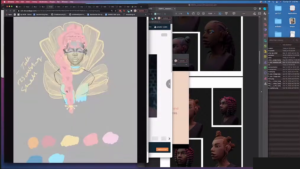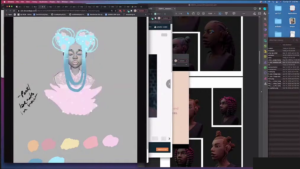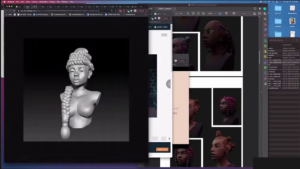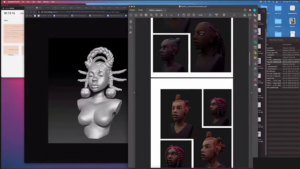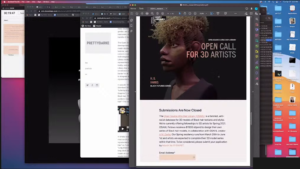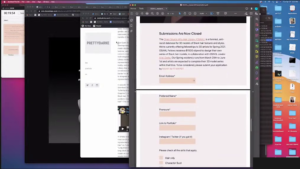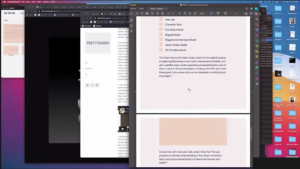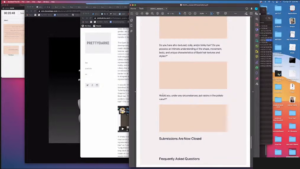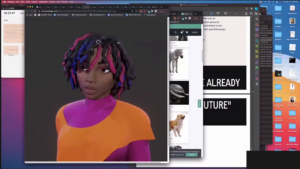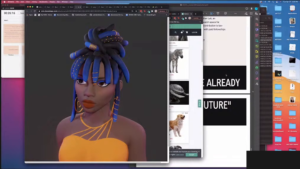Golan Levin: Tonight we’ll have three presenters. At 5:00 PM, now, at Eastern Time, we will hear from A.M. Darke, who has been developing the Open Source Afro Hair Library, a feminist, antiracist database for 3D models of Black hair textures and styles. At 5:30 PM, Bomani Oseni McClendon, a member of a small team developing ml5.js, which is a library that aims to make machine learning approachable for a broad audience of artists, creative coders, and students. And at 6:00 PM, Valencia James, creator of the Volumetric Performance Toolbox, a software system for movement artists of all ethnicities, cultures, and abilities to create immersive performances online.
Our first presenter, A.M. Darke, is an artist and gamemaker designing radical tools for social intervention. Still in the class war. Now in the pandemic. He’s in the combination class war and pandemic. Assistant Professor of Digital Arts and New Media, and Critical Race and Ethnic Studies, at UC Santa Cruz, Darke also directs The Other Lab, an interdisciplinary, intersectional feminist research space for experimental games and new media. She recently launched ‘Ye or Nay?, a Kanye West-themed game about Black culture, and is currently developing the Open Source Afro Hair Library, a 3D model database for Black hairstyles and textures. Darke holds a BA in Design and an MFA in Media Arts, both from UCLA. Her work has been shown internationally and featured in a variety of publications, including Kill Screen, Vice, and NPR. A.M. Darke.
A.M. Darke: Hi everyone. Please let me know if I have any audio issues. There’s major construction going on right outside my window.
Yes, thank you so much Golan for that wonderful introduction. I’m going to get right into it. I only have twenty minutes and I talk a lot. So, let me get started with the screen share.
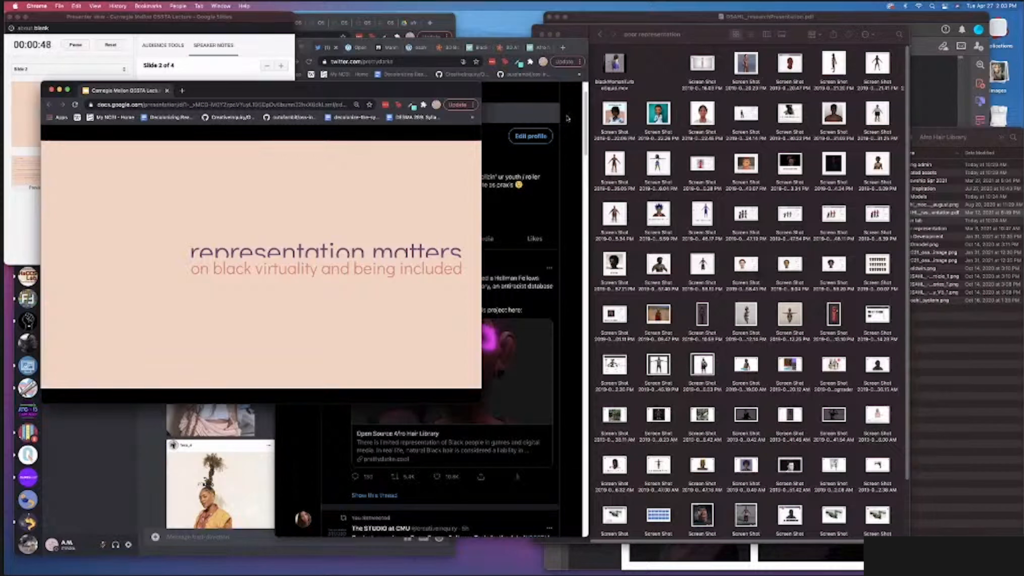
So, everybody can see that. You can see my notes. It’s gonna be a very transparent talk.
Okay. So, the Open Source Afro Hair Library is what I will be talking about today. My talk does actually have a title, and it is “Representation Matters: On Black Virtuality and Being Included.”
So, I wanted to talk specifically about visual representation and inclusivity, and really trying to problematize the way that we conceive of inclusivity as an inherent good. This is not a sort of “hashtag representation matters” talk, it is a talk that’s thinking about you know, matters around representation and how to do that in a way that is non-instrumentalizing and non-exploitative. All of my work is about power and representation and identity, and for most of my practice I’ve been focused on sort of what I would say is maximizing agency for marginalized bodies, usually thinking through my own narrative and the external and internalized barriers I have faced.
To be perfectly honest, most of my work has been maybe too celebrated by white liberals? And that always makes me feel like I’m not doing enough. And the current trajectory of my work has moved away from that sort of like, liberal individualization, that sort of individual freedom, to really trying to move beyond representation and move into collective liberatory practices. And so I think of the Open Source Afro Hair Library as not just a sort of database of Black virtuality but also thinking through decolonizing practices and how can I decolonize the design, how can I foster new forms of community. And so I’m gonna talk I’m pretty thoroughly about that.
So, first things first. Okay I’m creating a database of Black hairstyles and textures. But why do I need to do that? How did this project come to be? Like why is this important?
I want to start by showing you some of the research that I started collecting in 2019, to give you the landscape of what Black virtuality looks like right now. So, I have a folder here that’s research I collected from CGTrader and TurboSquid. These are 3D asset marketplaces where you can buy—sometimes they’re free to download but you know, free to download or monetized 3D assets that are created that are submitted by individual creators and then sold on this platform. And so I’m just gonna pick a few from here.
So, this is from TurboSquid. Here’s a depiction of Blackness that you’d find if you were to search for “afro hair” or “Black hair.” Right. We’re seeing these kinds of really gross caricatures of Blackness.
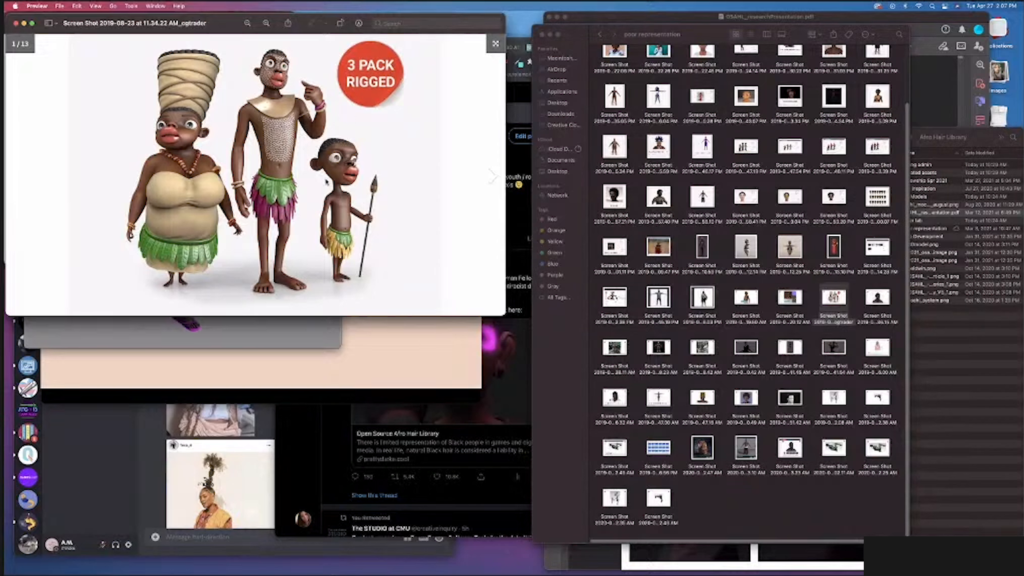
Here’s another image. Immediately, this harkens back to that Jim Crow era of Black caricatures. And I found this really disconcerting, not only because I was really just looking for depictions of Blackness, specifically looking for Black hair. But it’s unnerving to me that these kinds of images that other forms of media have long locked away in their vaults and considered you know, problematic and racist are now being reproduced in this sort of cutting-edge technology.
So, these are some of the most egregious, but in searching for Black hair I came across images like…
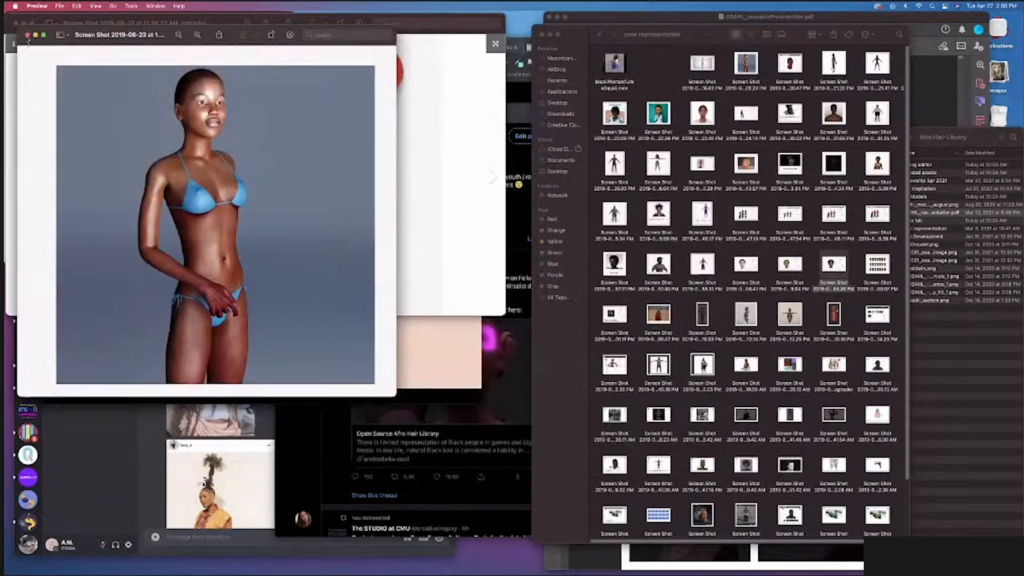
This. Not very detailed hair, not very high-quality model.
Here’s a series of three depictions of Blackness. This is “Mixed Race Jerry.” As a mixed race person, I’m deeply offended by this image. We have…again, this is supposed to be a Black person. You can look at the details of the hair, doesn’t look like Black hair that I’ve ever seen.
You also see these sort vaguely tribal depictions, similar to this one. You have things like this.
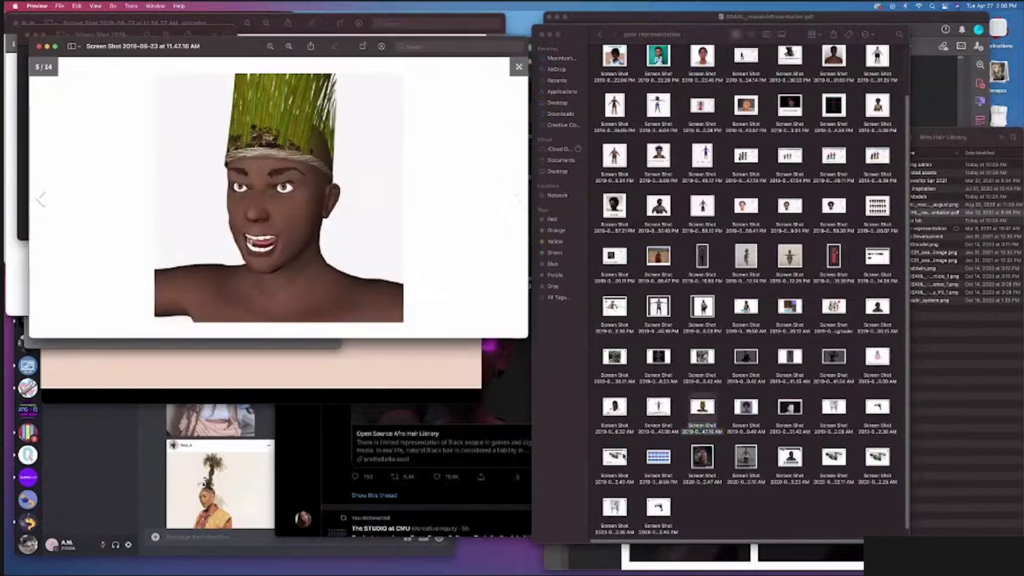
Basically if you’re looking for depictions of Black hair in particular, you end up with these sort of minstrels or mammys.
You end up with hypersexualized depictions of women. Here this model’s actually …with her braids, but then this woman is bound by rope around the wrists and around the neck. And so all of this I found very problematic.
Two issues, outside of the representation that I wanted to talk about was when I was looking for Black hair, even entering the search term for Black hair into these sort of databases became a problem. Because these systems are not designed to think about Blackness in the way that I think about Blackness. When I’m looking for Black hair, I’m not looking for a sort of color description, I’m looking for something that reads as an ethnic description. And so that was a struggle. Even now— I can pull this up.
So some of this has changed because my work has become more public. I’ve had people from these companies reach out to me and talk about their awareness of my work. But here’s a query for Black hair. You can see we’ve got horses, we’ve got this long black wig on a hypersexualized body. More animals than Black people. This is very new. This has happened within the last year. So not really what I’m looking for. So even in this search term looking for Black hair, I have to sort of figure out how to make Blackness as an ethnic descriptor legible.
And so I have to…you know, if I search for Afro hair then you get a little bit closer. You see these kind of hairstyles. But again, they’re very limited. There’s not much diversity. Adjacent to these sort of like, inoffensive but not high-quality models you also get things like this:
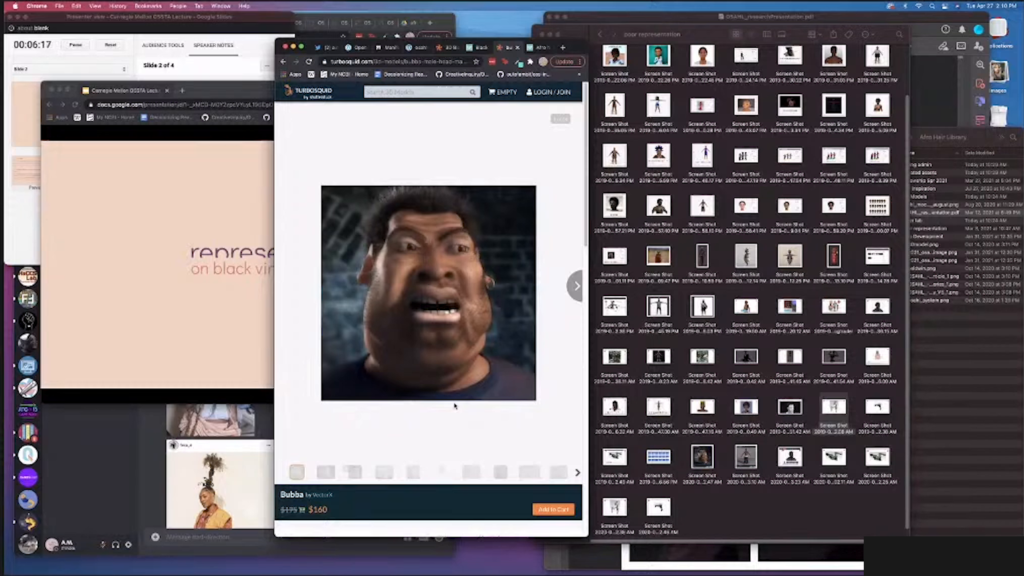
…going back to the kind of caricaturized, very limited, narrow depictions of Blackness.
And so this is the reason for the Open Source Afro Hair Library. Not just to sort of control the kind of representation of Black virtuality, but also to…opt out of these sort of capitalist, corporate systems, right. You know, even if I were to say well I just want to create these wonderful models, and I want to upload them to these sites, we have another problem. We have the problem of you know, look how much it costs to purchase Bubba, this depiction of Black virtuality. It’s $160. You’re getting a deal. It’s like, discounted, right?
But I take issue with the idea of buying and trading Black bodies. It reminds me of something. And I don’t really want to engage in that system whatsoever.
So instead, I decided that the way to deal with this would be to create my own web site, collaborate with Black 3D artists, pay them, and support them, give the material and community support to be able to craft our own depictions of Blackness. And so I’ve sort of giving you the lay of the land of how things are. Now I want to show you what it looks like when Black artists collaborate and are in control of our own depictions.
So, these are the first images created by a 3D artist named H.D. Harris. This was basically the proof of concept. I worked with them, I told them what I was looking for. I talked about wanting to commission these 3D models that communicated not just representations of Blackness but how do we represent queerness, how do we have a voice, and how do we put that voice—a radical, pro-queer, pro-immigrant, pro-Black, really the antithesis of all of the things that I see in these sort of capitalist spaces—how do we create all of that, just in this visual language of Blackness. And so these were the initial concepts. I think they’re absolutely stunning. And this really kickstarted this project.
So, I’m showing you some representation—and I’m going go to my notes so that I remember. Alright, there’s three things that I want to touch on. So, here I’m at the second part, where I’m talking about expanding the Black virtual imaginary. So, these are some initial images. But I’m gonna really focus the final part of my talk around this practice of collaborating with Black artists.
So after getting the sort of proof of concept, and applying to some grants, and getting some funding, what I did is I developed the Open Source Afro Hair Library 3D artists in residence fellowship program. And this is actually the very first time I’m running it. It’s happening right now. We’re about half-way through. And I was able to work with an international collective of artists. We have folks from Kenya, Nigeria, London, Belgium, Oakland, Atlanta, and Los Angeles. And we’re in the process of developing these models to seed the library. And I’m gonna talk a little bit about what this practice looked like. Like why I’m doing this fellowship model. How to really…once again get back to the sort of liberatory practices, get outside of representation.
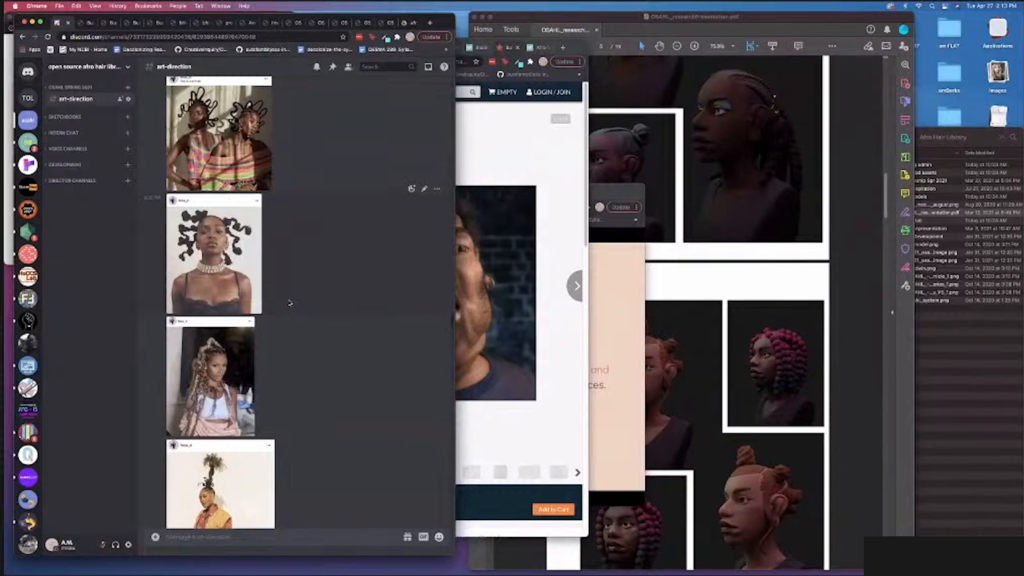
So in the fellowship model, what we’re doing is creating a space for Black artists to come together outside of a sort of white gaze, outside of this external pressure, to be able to have real conversations about expanding Black virtuality. The idea of the library is that we don’t simply sort of serve users what they’re looking for. You can imagine that a traditional web site like this is usually looked at as a utility. Users come to the web site and they search for exactly what they’re looking for, and the entire idea’s to serve them that result as quickly as possible.
But with the Open Source Afro Hair Library we are making the presumption that we don’t want to serve the user what they’re looking for if what they’re looking for is limited. In the worst case by you know, the systemic racism that we’re all entrenched within, or just by the lack of beautiful, sublime representation. As you could see in some of the images I showed earlier, there isn’t really anything that I find to be elevated or challenging. And so that’s what we’re doing through this fellowship. And I want to give you— This is a sneak peek; this is super secret. No one has seen this. I got some permission from the artists to show some of their works in progress.
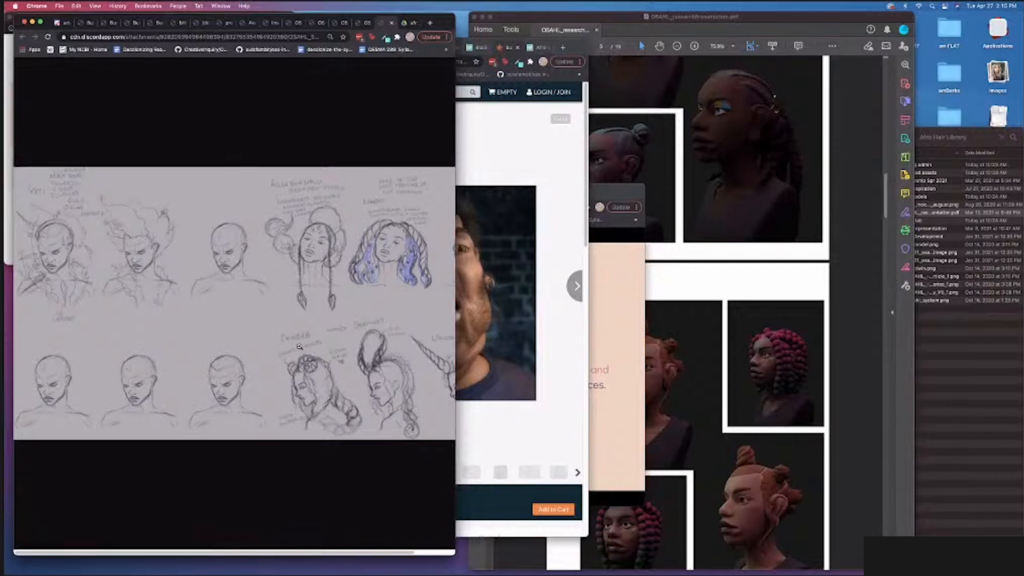
So this is what we’re coming up with together when we’re outside of sort of external pressures. So these are some sketches for hair ideas. Every artist has their own artist statement. They develop their own theme. They develop a series of models to work with their own character bust. Here this person Cicada is working with mythical creatures and creating really lovely images. There’s some more of those. I’m going to show you a sampling here.
This is H.D. Harris, who’s also doing a fellowship, who created the original images. I believe that their inspiration for Blackness is thinking about hair as technology. And so they’re in the middle of developing this series, which are just incredibly stunning images.
This is an artist Malika[sp?]. These are some of their initial sketches, and so they’re in the process of now modeling these out.
And as you can see, we’re never looking at— The reason why every— So, every artist has to create this character bust and they design this series of hairstyles. In the Open Source Afro Hair Library we never sort of disembody, we never just take the hairstyles and leave them floating. Everything is always presented fully colorized and with the character model. Because we’re not looking to sort of create these piecemeal versions of Blackness. We are always looking at the human. Even in a sort of fictional context, we’re looking to create these depictions of Blackness that are whole.
This artist is Timid Clover. This is an initial sketch. Here are some of the images that she’s in the middle of creating.
This artist is Javon.
And here are some of Javon’s 3D models.
So these are the sort of expansions of Black virtuality that we’re looking for and that we’re working with in the library. So I wanted to show you this. But then I also wanted to sort of show you the design work. Like how are we going through the process of trying to decolonize the narrative experience of navigating this web site.
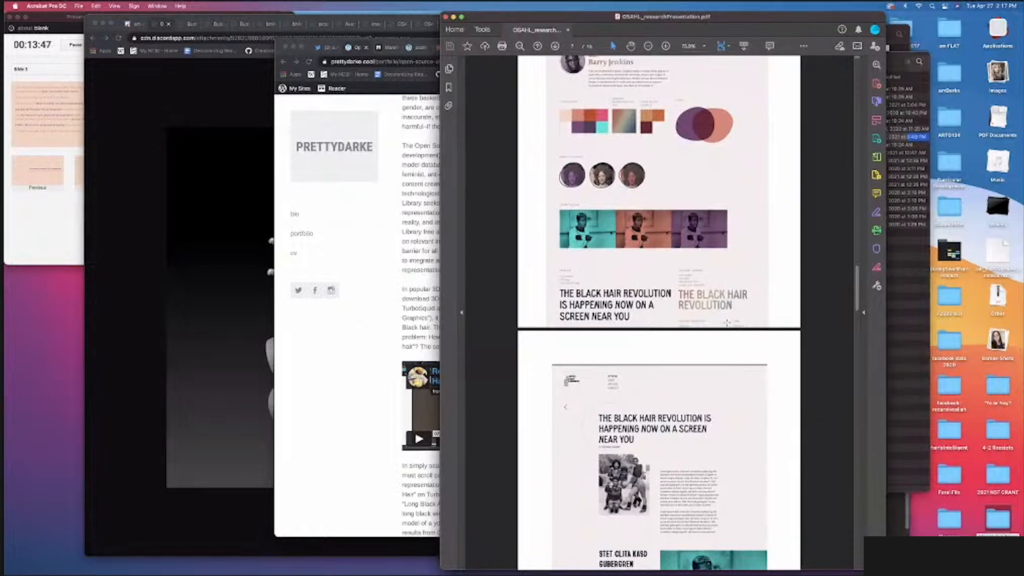
So, as Golan introduced I do have a design degree. And so there’s been a lot of background work in addition to working with artists and sort of going back and forth with this art direction and collaborating with them. I’m working with the web developer Estevan Carlos Benson, and we have spent months really thinking about the design system of the web site itself. Not only eliminating a search feature, but really trying to figure out how do we immerse an audience into the space so that it doesn’t become just a resource where you come and sort of extract Blackness and then leave Black culture behind, or you extract these Black models but leave the Black creators behind.
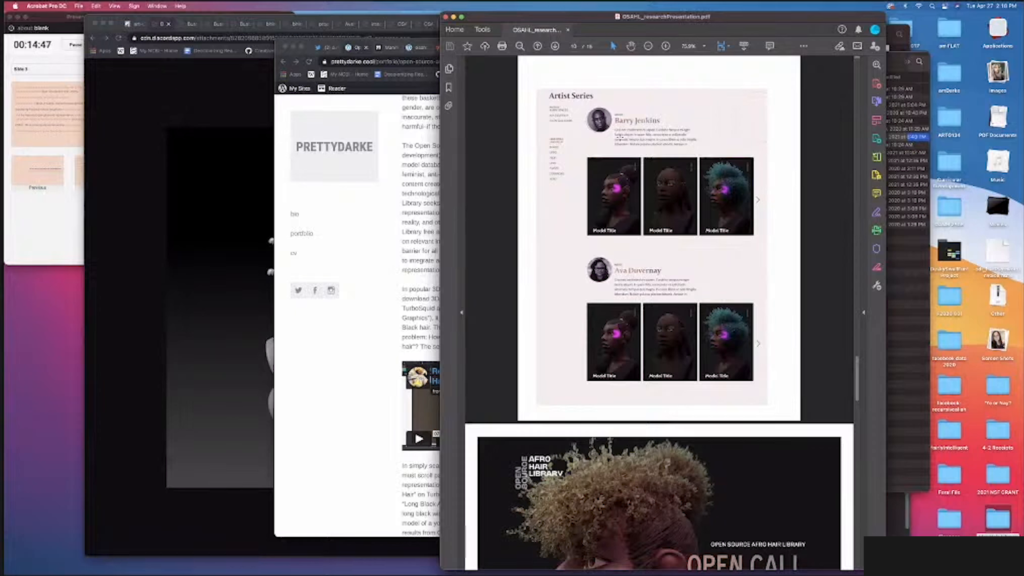
And so one of the things that we’re prioritizing as you can see from a mockup of our artists page is that everywhere where you see a model, you also see the artist equally highlighted. I’m drawing a lot from the fashion industry here in terms of the way that I’m thinking about this design series. …just as important if not moreso than the objects that they create, right. The name matters. When a new series is launched, you want to hear what the inspiration and the backstory is from that designer because you respect them as an artist.
And I find it you know, funny, that in these technological and software spaces, 3D artists are actually treated much more like garment workers in the sense that the people who are actually creating these beautiful objects that are used in all of these applications, their labor is invisiblized. They’re not seen. What you see is the sort of director, or producer, of a game or a large experience but you’re not seeing the artists who crafted this vision. And so it’s really important that in creating the library my relationship with the artist is not just what can you produce for this project or this vision I have, but how are we working together, how are we platforming and amplifying your vision? How are we basically creating the space and support for you to create depictions of Blackness that maybe in a different context you wouldn’t have the financial means to do so, or have the time to do so. And so again, elevating the artist and never sort of extracting their work and leaving them behind.
Also the fact that the… I want to talk a little bit about why the Hair Library is open source and the sort of limitations of that. You know, I said that I wanted to work outside of a capitalist model and I didn’t want to engage in the buying and selling of Black bodies. And so I thought an open source project would be excellent for that where I could pay Black artists to create these models and then they would be available widely for any kind of use, for both— You know, my ideal sort of target audience is actually a young Black femme who doesn’t even know if they want to make games or if they want to get into software. Maybe they’re not even looking for 3D models. Maybe they’re just searching for ways to style all of their wild hair, and they stumble upon this web site and they’re just taken aback by these amazing depictions, and that they know upon entering the space that it was designed specifically for them. Like this is my goal with the library. And so making it open source so that it is available and it’s accessible is really important to me.
On the other hand, I feel that while I want to avoid a proprietary relationship to Blackness I’m not trying to own Blackness. I do feel a kind of protectiveness. And so we’re having to think about the construction of this library in ways where…how do we make it non-neutral? How do we keep— How do we make this open without making it open for exploitation? And so there’s a few different ways that we’re trying to do that.
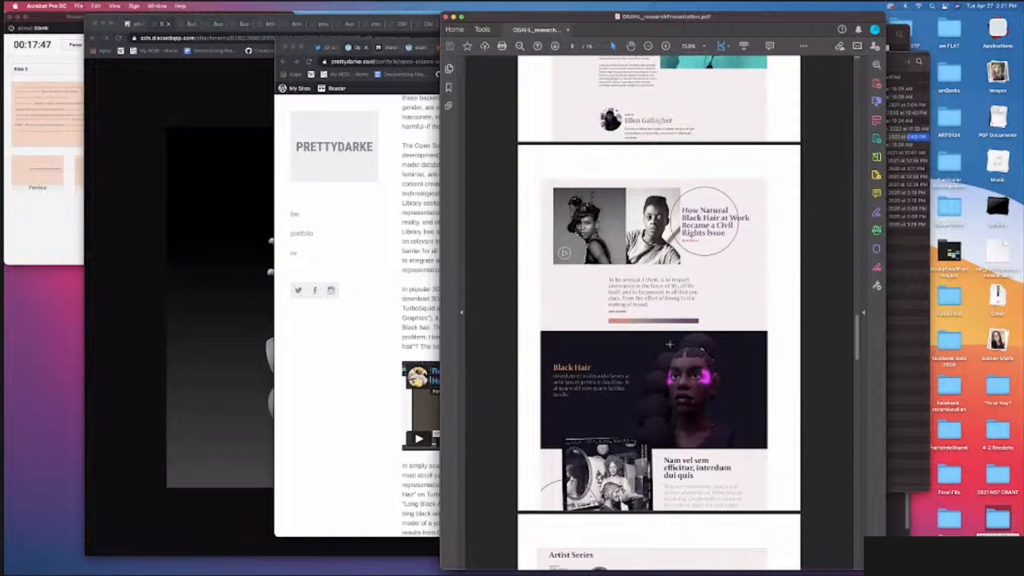
So one is through again, the navigation. I’m showing you this mockup here because I want you to see that this is not a site where you just see 3D models in the sort of gridded list. You’ll see 3D models sort of interspersed on the page along with articles around the historic politicization of Black hair. I want this to be really a site of cultural production and reproduction, where you can just as easily stumble on a playlist full of emerging Black artists and other kinds of Black cultural media. And so it’s not just “here’s a model.” It’s really less of a utility and more of an invitation to invest in the Black community.
Let’s see, how am I doing on time.
So, one of the things that I’m thinking about when I develop this kind of work— And I do want to leave time for questions so I’ll stop in a couple of minutes so we have ten minutes but— It’s really important to me to get out of the sort of normative, false neutrality that I see in so many tech spaces. Like everything…especially in these large marketplaces, everything seems to be sanitized. There’s no voice. It’s meant to be neutral, apolitical. And that’s not something that I’m interested in. I’m interested in creating a technology and tools and spaces that make a statement, that have a polemical voice. And so every aspect of this residency as this social practice work, is how I think of it, I have to sort of push back against doing things that’re default or really just following established practices.
And so one example of that is recently we did the open call, and I am very invested in making submissions quick and easy for artists and respecting their time. So here’s the open call that went out. This was posted on afrohairlibrary.org. And as you can see you’ve got some typical things: name, address, pronouns, portfolio. All of the things that you would expect. You know, what skills a person has.
But then, making the statement very clear up front that the Open Source Afro Hair Library exists for the explicit purpose of depicting Blackness in anti-racist, intersectional feminist, anti-capitalist ways. And asking why people are interested in contributing to the project. Asking if potential collaborators have afro-textured, coily, or kinky hair. Do you have the kind of hair that we’re looking to depict? And if so or if not do you understand, do you have an intimate understanding of the shape, movement, and body of this kind of hair.
And my favorite question, which has functioned as a really excellent screener—and again, reaffirming that idea that we are non-neutral, that we have a voice—is my favorite question: Would you under any circumstances put raisins in the potato salad?
Now, I will say this is somewhat limited to a Black American experience. But as I found out through the sixty or so applications we’ve received, there is a diaspora connection, just an intuitive understanding that no, hell no, raisins do not belong in potato salad. So it was really a fun opportunity to see how people would respond to that question. And it really was an effective screening.
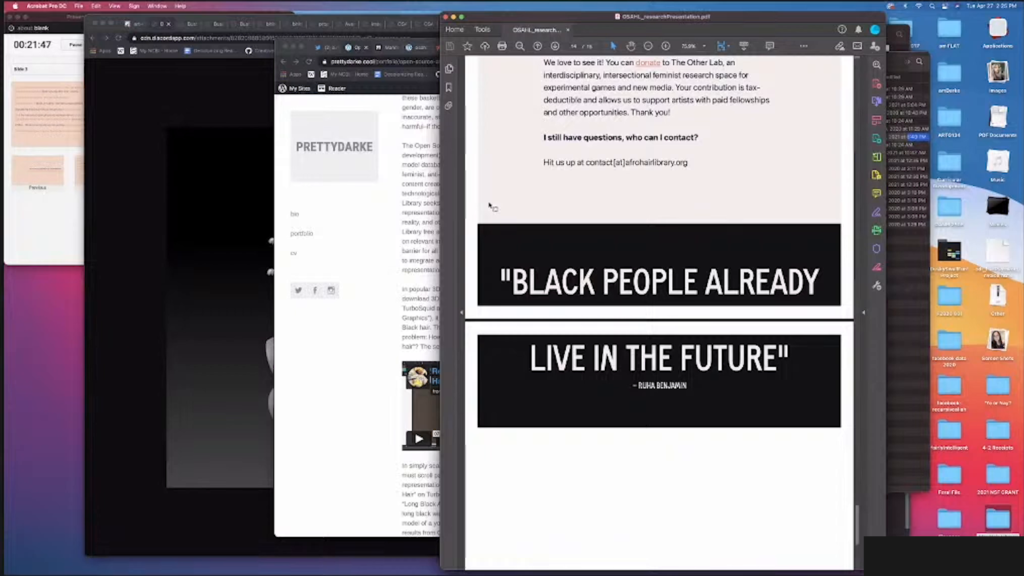
Oh, I love to end with this quote from Ruha Benjamin. Her book Race After Technology has been such an important work that’s informing my practices here. One of the things that she says is that Black people already live in the future. And I think that that statement is really driving all of the work that I do and all of the ways that I’m thinking about the Library.
Yeah. Usually I talk way too much and I answer every questions so I’m gonna hold back to allow people to actually ask those questions. Yeah, that’s my presentation. Thank you so much.
Golan Levin: Thank you so much A.M. So we do have some time for questions, which is fantastic. And I see a few questions in the YouTube chat so I’m gonna pull from there. One person asks, I think it’s a fairly simple question, “Curious if in the early searching for examples in 3D marketplaces more from-the-community terms like say, ‘natural hair’ turned up less sketchy results than more open or familiar terms.”
A.M. Darke: Oh. You know what? I don’t remember. I’m literally going to search this right now because I’m so curious. Let’s see what happens if I type in “natural hair.”
Ooh, okay. I’m gonna share screen again so that y’all can see.
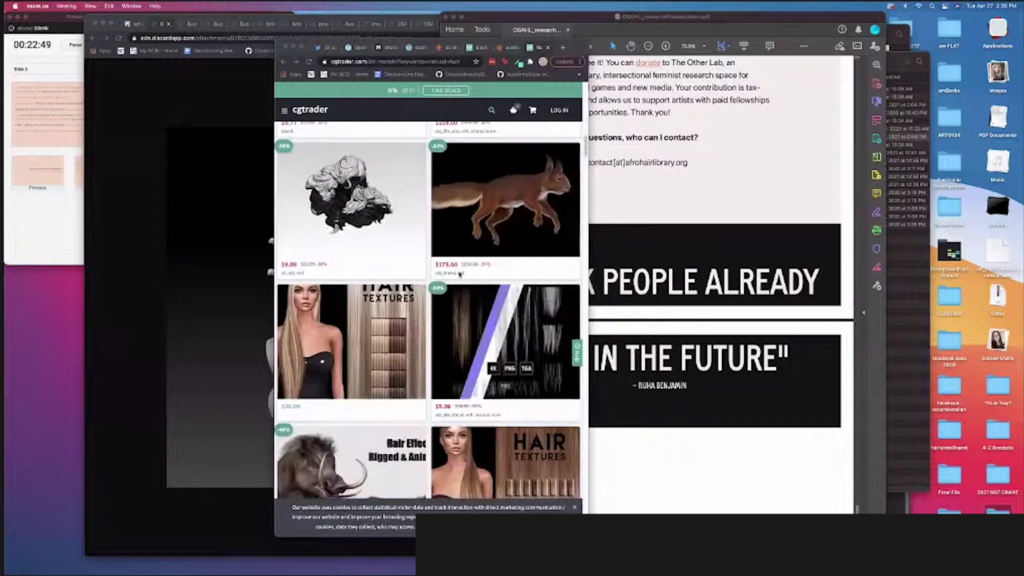
So “natural hair”…is like, worse. This is actually closer to what “Black hair” initially returned. This is really funny. So yeah. When I initially searched for Black hair when I was writing grants, like, there would just be pages and pages like cows and animals. Yeah.
So, to answer that question about from-the-community terms…no. It doesn’t work. And so I actually— The initial title of the Open Source Afro Hair Library was the Open Source Natural Hair Library. But I changed it. Because you know, maybe ten years ago natural hair was an intracommunity term. But then it became you know, as it does, kinda appropriated and it’s like anybody with curly hair regardless of their historical struggle with said hair is “natural.”
And there also became a kind of fetishizing of natural hair. Like if you look at Instagram natural was still kind of hair like mine that was looser-textured or really sealed, and coily and shiny and natural hair wasn’t—like Type 4 hair—kinky, coily hair was not being celebrated as natural as part of that beauty standard. And so I actually made an intentional choice to change from natural to use the term “Afro” in part because I felt like the historical power of Afro, right, like not just representing a diaspora but also the afro as a political symbol, would offer a kind of historicis—histor…I can never say that word—and longevity. Yeah. Thank you.
Levin: Another question that maybe this leads into. Someone asks, “I’m interested in the conversations around balancing creating daily hairstyles versus couture or more imaginative hairstyles.”
Darke: Yeah. So, again this is the first iteration of the fellowship. And we have seven full fellows. This is also a sort of counter-practice that I did. There were many fellows who I felt didn’t quite fit what I needed for the fellowship, which was to seed the library with these 3D models. They may not have been 3D artists or maybe weren’t totally aligned. But we did this low-residency fellowship where I gave 10% of the stipend and there were no deliverables required. So it was really like a gesture and investment of bringing more people into the community outside of just being able to produce these kinds of models. And so that has really enriched the conversation, where we do have some folks who are doing this really high sculptural work.
But then you know, two artists— Actually Timid Clover, if I can bring those up just so that you have the reference on screen.
So, this series in particular, Timid Clover’s inspiration was sort of they want to do all lock’d hairstyles, but going from everyday to regal and this sort of movement back and forth. And so I really have appreciated Nikki’s input here in saying we’re not just going to do high couture, it’s going to be sort of relatable but also flexible and dynamic. And that’ll come out in their— This is also why we have artist’s statements because I think that insight into what the creator’s thinking about and what inspires them is really powerful, and that’s how we… You know, again we don’t dictate the terms of Blackness, but we invite and we get to open up those conversations. And of course there will be ongoing fellowships and I’m always thinking about the sort of total spread, making sure that we are covering many different bases.
Levin: A.M., we need to close there. I want to thank you so much for sharing your Open Source Afro Hair Library with us all here, both in our residency and now with everyone online. There are some more questions we didn’t have time to address. If you look in the YouTube chat, some questions about “extracting Blackness” and how that relates to licensing which I think are really super interesting. We’re gonna shut down. You and I will turn off our cameras. And we’re gonna come back in just about a minute and a half a href=“http://opentranscripts.org/transcript/spring-2021-ossta-lecture-bomani-oseni-mcclendon”>with Bomani McClendon.
Darke: Thank you!
